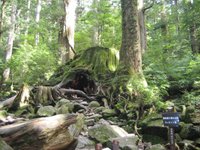David @ Tokyo
Perspective from Japan on whaling and whale meat, a spot of gourmet news, and monthly updates of whale meat stockpile statistics8/31/2006
Summer Holiday 2006 - Day 3
We had our alarm clock set to get us up by 04:30 so that we had plenty of time to get to the nearby bus stop. Getting up was not such a hard job as we hit the sack early the previous night, and had already been woken up by the people in the room next door when they left at 03:30 - they made a huge noise opening and shutting a closet or something.
 Anyway, out we ventured into the early morning darkness, and after a 10 minute wait the bus chugged along, pretty much right on schedule at 05:20 or so.
Anyway, out we ventured into the early morning darkness, and after a 10 minute wait the bus chugged along, pretty much right on schedule at 05:20 or so.The bus ride back up the east coast and then up into the mountains took around an hour from our location on the south at Onoaida, and at the last stop we picked up some breakfast and lunch boxes from "Asahi bento". We had told the guy at our minshuku that we were planning to get up early and climb the mountain, so the previous night he had called up this place to arrange for our breakfast and lunch to be waiting for us at the second to last bus stop. As we wound our way up through the mountain on the bus to the hike entrance way, we got another view of a nice sunrise. The road was pretty nasty so I was happy to not have taken the car, although cost wise the price on the bus was about 1160 yen, so overall it might have been better to go with the rent-a-car at 4,500 or so a day.
Once we arrived we could see that there were quite a few people doing the climb. Our bus was basically full, and the car park had heaps of vehicles.
We chowed down on our breakfast, before it started to rain, and rain pretty hard as well. A work mate of mine had told me a bit about his time in Yakushima, and they say that when it rains it rains hard, but only for about 30 minutes at a time. That's how it turned out - after about 15 minutes of waiting under shelter we said "hey let's go" and by the time 07:00 came we were 15 minutes into our hike and the rain had basically stopped.
Basically the entrance to the hike path is actually something like an old station. The first 7 or so kilometres of the hike is on a tiny little railroad track. At the entrance they have a whole load of rusty looking equipment there. It seems like they built this track into the mountain, where they would go and cut down cedar trees, and then transport them back down. After we had walked along on top of the track for about an hour or so, we heard some loud horn type noise coming from behind us, and as we passed a guide leading some other tourists up the hill he told us to get off the track - the horn was apparently that of a little locamotive that was coming up the hill. It was a dinky little thing too, with about 3 guys sitting in it.
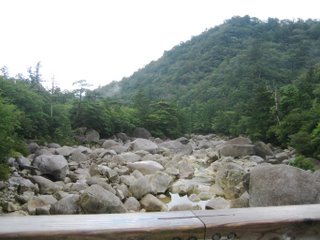 We kept walking, and eventually came to fork in the tracks. I guess the little locamotive went off to the left, but the line veered across a river to the right, which was apparently the path to the Jomon Sugi. Here the photo shows the view from the top of the bridge - there are masses of massive rocks like this all over Yakushima it seems.
We kept walking, and eventually came to fork in the tracks. I guess the little locamotive went off to the left, but the line veered across a river to the right, which was apparently the path to the Jomon Sugi. Here the photo shows the view from the top of the bridge - there are masses of massive rocks like this all over Yakushima it seems.Over on the other side of the bridge was the site of an old Junior High School. We didn't notice that until on the way back down, later in the afternoon actually, and we wondered who in their right mind would send their kids to school in a place as remote and hard to get to as that - which is why the school shutdown I suppose :-) Presumably it was for the kids of families who were working on the mountain in past years.
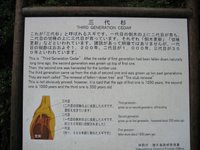 There was an interesting sign board too about how the cedar trees grow - click on the picture to get a bigger view.
There was an interesting sign board too about how the cedar trees grow - click on the picture to get a bigger view.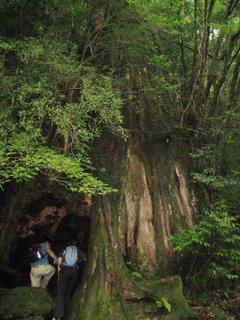 The next picture seems to show just such an example of one of these hollowed out cedar trees. I can't really remember this actually, but I think you could walk around inside this guy. He's a big boy, that's for sure.
The next picture seems to show just such an example of one of these hollowed out cedar trees. I can't really remember this actually, but I think you could walk around inside this guy. He's a big boy, that's for sure. To the left is a picture of the dinky little train tracks, with Kana chugging up them in the lead. These train tracks went on forever really - 7 or so kilometres, uphill, is pretty tiring stuff. But... this was the easier part. It got a whole lot harder after that...
To the left is a picture of the dinky little train tracks, with Kana chugging up them in the lead. These train tracks went on forever really - 7 or so kilometres, uphill, is pretty tiring stuff. But... this was the easier part. It got a whole lot harder after that...[UPDATED 8/30]
Another thing about Yakushima (and I guess other places too) that you don't get back in New Zealand is lots of large fauna. So many of our native birds are sadly endangered, but on Yakushima there are heaps of monkeys and cute little deer. Apparently in Japanese religion deer are considered to be messengers from the gods. We had seen some deer on the bus ride into the middle of the island earlier in the morning, and then also as we made our way up the mountain on foor we frequently came by one foraging for food. There's actually one in the picture with Kana just above, and here is another up a bit closer: Eventually after about 2 hours of walking, we reached the end of the rail track, which also had plenty of place for resting. There were toilets here too, which were quite interesting, as they were completely self contained. So as to not spoil the nature, the toilet block apparently has some kind of treatment functionality built into it, and the human effluent is re-used to the maximum extent possible as toilet water etc. Of course, this meant that the toilets absolutely reeked like anything, but one could really appreciate the thought for devising such a thing, so as to have the minimum possible impact on the great nature.
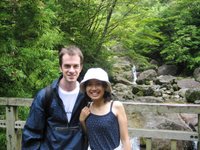 Another great thing about the hike was that there was really no litter at all. The whole walk was absolutely spotless, so it gave the impression that the people with the spirit to walk 7-8 hours up and down the mountain also had respect for it as well. No photos of the toilets I'm afraid, but there was another nice waterfall to be seen here.
Another great thing about the hike was that there was really no litter at all. The whole walk was absolutely spotless, so it gave the impression that the people with the spirit to walk 7-8 hours up and down the mountain also had respect for it as well. No photos of the toilets I'm afraid, but there was another nice waterfall to be seen here.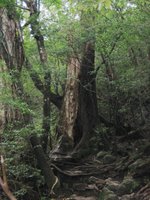 Where to from here though? The rail track ran across the bridge from which we took the photo to the above-right, spotting in a dead end at the toilets, and it was then that we realised that the next part of the hike was up these dinky little stairs that we had seen on the other side of the bridge. These little stairs were steep, giving us the impression that the final 3 km to the Jomon Sugi would be tough going, and indeed this was no deception. From here on we would often have to take a look around to figure out where the path had gone, as it was no longer completely obvious.
Where to from here though? The rail track ran across the bridge from which we took the photo to the above-right, spotting in a dead end at the toilets, and it was then that we realised that the next part of the hike was up these dinky little stairs that we had seen on the other side of the bridge. These little stairs were steep, giving us the impression that the final 3 km to the Jomon Sugi would be tough going, and indeed this was no deception. From here on we would often have to take a look around to figure out where the path had gone, as it was no longer completely obvious.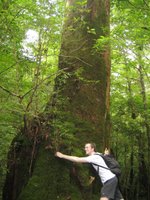
Still, there were many more beautiful sights and cedars along the way to enjoy. We took the opportunity to indulge in some tree hugging, who didn't seem to mind.
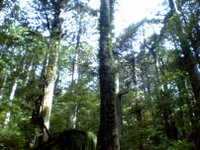
Around half way through this second phase of the hike we arrived at the "Wilson Cedar". I'm no cedar expert, but from what I can tell there is apparently some type of cedar named after a chap known as Wilson, and anyway, there was another large area here where people were resting and taking photos. The Wilson Cedar itself was again a big hollow fellow, who you could walk inside. A little minature shrine was present inside the hollow.
Looking straight up from inside the hollowed out cedar, one could also spot a love heart shape if you turned your head and camera at the right angle :-)
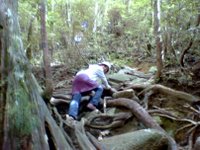 But onwards we had to go! The climb continued, scrambling up over branches and rocks, where there was no foot path.
But onwards we had to go! The climb continued, scrambling up over branches and rocks, where there was no foot path.Along the way we found a "World Natural Heritage Area" sign board. Kana, having travelled extensively has apparently taken her photo alongside many of these signs, so she added another to her repotoire.
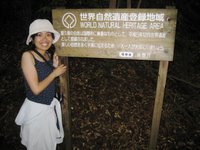
 At some point earlier on the second phase of the hike I asked some guys who were coming back on their way down how much longer would it take us to get to the Jomon Sugi. "Maybe 40 minutes, if you're fast!" they had told us. 40 minutes came and went - apparently we were not so nimble.
At some point earlier on the second phase of the hike I asked some guys who were coming back on their way down how much longer would it take us to get to the Jomon Sugi. "Maybe 40 minutes, if you're fast!" they had told us. 40 minutes came and went - apparently we were not so nimble.But getting there we were, when we came across another fairly famous site on this hike route - a pair of cedar trees that are apparently husband and wife. They are connected together by the branch you see. A durable marriage it seems.
Finally, after more than 3 hours climbing (not including time taking resting and taking photos), we finally arrived at our destination:

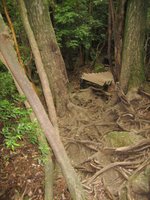 That's it! The Jomon Sugi - somewhere between 2000 and 7200 years old, depending on who you want to believe. We got there at around 10:50, having started out at about 6:45 am. Was it worth it? For all that we saw on the way, most definitely. There was another rest area nearby, where we took another 30 minute break for lunch, before we started our descent back down...
That's it! The Jomon Sugi - somewhere between 2000 and 7200 years old, depending on who you want to believe. We got there at around 10:50, having started out at about 6:45 am. Was it worth it? For all that we saw on the way, most definitely. There was another rest area nearby, where we took another 30 minute break for lunch, before we started our descent back down...An amusing episode about 10 minutes after we had set out again was as we gave way to another couple making their way up the path. "Why did you go and bring me to Yakushima to climb up this hell of a path?" moaned the exhausted looking lady. "It was you who said you wanted to come here!" retorted her male companion with a smile of irony on his face as they went by. Ah - true love!
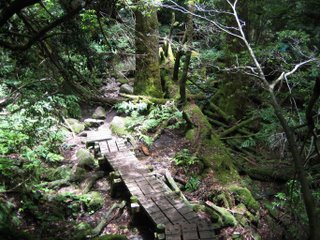 By 13:15 we made it back down to the rail track area and took another break. At this point, and further up the path there were springs of water to quench the thirst, so there is no need to carry a massive 2 litre bottle the whole way up the mountain with you. We took a couple of 350ml guys, and probably filled up a couple of times each along the way.
By 13:15 we made it back down to the rail track area and took another break. At this point, and further up the path there were springs of water to quench the thirst, so there is no need to carry a massive 2 litre bottle the whole way up the mountain with you. We took a couple of 350ml guys, and probably filled up a couple of times each along the way. We took a rest, sitting on the rock beneath the rail bridge, enjoying the waterfall (and the fact that we were 3/4 of the way through the day).
We took a rest, sitting on the rock beneath the rail bridge, enjoying the waterfall (and the fact that we were 3/4 of the way through the day).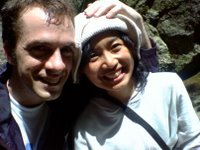 Summoning a little more strength, we set off back along the loooooong rail tracks. We reached the hike entrance at around 15:30, giving us 90 minutes to kill before the 17:00 bus came to take us back to Onoaida. This was a time it would have been nice to have the rent-a-car, but just splaying out in the car park, taking in the sun and blue skies was a more relaxing way of finishing off the afternoon.
Summoning a little more strength, we set off back along the loooooong rail tracks. We reached the hike entrance at around 15:30, giving us 90 minutes to kill before the 17:00 bus came to take us back to Onoaida. This was a time it would have been nice to have the rent-a-car, but just splaying out in the car park, taking in the sun and blue skies was a more relaxing way of finishing off the afternoon.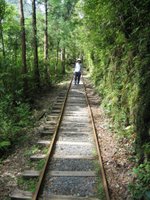 Time for an anecdote with a moral!
Time for an anecdote with a moral!When the bus did arrive we made sure to jump on and get ourselves a seat, but while we were waiting to depart we noticed some big signs stuck around, reading along the lines of "there is no change for 5,000 and 10,000 yen notes available on this bus, you must pay the fare with the correct amount".
Hmmm. The smallest denomination that we had on us was 5,000 yen, but the bus fare was going to be only 1,160 yen or so. I mentioned that we might have a problem in this to Kana. We needed to get change, but where? We were already in the middle of nowhere. Should we ask some other passengers if they have change?
 Kana, who claims she is a New Zealander (she can sing the national anthem in Maori), deviously suggested that we could just sit tight and say nothing until we had reached our destination - there was only one bus back out of the mountains, and this was it - we needed to be on it. Maybe we could sort the money out later somehow - maybe our hotel could help us out? Let's get off the mountain first, she advised.
Kana, who claims she is a New Zealander (she can sing the national anthem in Maori), deviously suggested that we could just sit tight and say nothing until we had reached our destination - there was only one bus back out of the mountains, and this was it - we needed to be on it. Maybe we could sort the money out later somehow - maybe our hotel could help us out? Let's get off the mountain first, she advised.Another of Kana's claims is that I am Japanese, and indeed my conscience got the better of me here, and I convinced her that we should talk to the bus driver about our situation in advance. There was surely no way they'd force us to stay on the mountain overnight for not having correct change. Being the foreigner (with the ability to play the "Oh I'm sorry, I didn't know" role), I got off the bus and frankly explained the situation to the bus driver, who was hanging around outside with the driver of another bus headed for a different destination.
"Ah, is that so? It's OK, we can get change for you at the bottom of the hill" the bus driver told me. Relief!
Feeling justified with my honesty I went back to my seat at the back of the bus and scolded Kana again for even thinking of pretending not to have seen the signs about the change, and being devious about it. (***)
Surely enough, when the bus wound out of the hills and hit the main road around the coast, instead of turning right to go back towards Onoaida, it took a 5 or so minute detour to a bus depot, where a man was waiting for us with change for our 5,000 yen. Great service! Although we felt a little bad for taking the bus out of it's way like that. A few minutes before we had arrived at the depot, the bus driver had made a call over the intercom for any other people without the correct change, but no one indicated that they too shared the same problem as us.
However, as the bus doubled back along the road towards Onoaida, another pair of travellers suddenly decided to come clean about something too - we couldn't hear the details, but it seemed that this pair also did indeed have a similar problem with a lack of change, but hadn't said anything when they had the chance. The bus driver's "are you kidding me?!" expression upon hearing this was almost priceless. There was no more doubling back for further change, and this new pair had to get off the bus where we had stopped, having no way to pay any additional fare.
"Honesty is the best policy"
We got back to our lodge, had another nice dinner out on the veranda, before retiring again for the evening.
* That's it for Day 3 - just a couple of more photos to add, when Blogger starts working again.
UPDATED [09/01]
(***) Kana tells me that I should be honest. Of course, she is usually thoroughly moral (just like me on this occasion), but after all, we had had a tough day climbing up and down the mountain. I'll cut Kana the slack that she deserves next time! No more teasing.
Labels: Kana and I, Summer Holiday 2006
8/26/2006
Whaling: JARPN II fleet returns, only EAI notices
It seems that the only whales that matter to the fund-raising groups are the ones in the Antarctic, because not only did groups such as Greenpeace and Sea Shepherd not attempt to obstruct the JARPN II research in any way, they don't even seem to have noticed that it has just finished, despite 256 whales being taken (100 common minke, 100 Sei, 50 Bryde's, and 6 Sperm whales).
The EIA ("Environmental Investigation Agency") has noticed though.
EIA is a much smaller anti-sustainable use group than Greenpeace but have been around for more than 20 years now. The EIA has a couple of it's staff members delegated by the anti-whaling UK government to attend the IWC Scientific Committee meetings, but apparently pay their own way to attend (here's a shot of their team in St. Kitts for IWC 58). The UK banner is quite significant for them, as they can then get their names in the media with "IWC Scientific Committee member" tagged to it. Their actual comments however destroy any mirage of credibility they may gain from it.
Let's take a look at the EIA has to say then...
"JAPAN’S ‘SCIENTIFIC’ WHALE HUNT SLAUGHTERS ALMOST EVERY WHALE IN SIGHT"...booms the headline. "Every whale in sight"! Quite catchy. Full marks to the EIA media department - what are they spinning though? We shall see...
The Environmental Investigation Agency (EIA) today branded Japan’s so-called ‘scientific’ whaling hunts ‘widespread devastation’ after revealing shocking new evidence of the scale of slaughter in the north Pacific.All that "widespread devastation" and yet the Greenpeace and Sea Shepherd eco-terrorists were conspicious by their absence. Guys? Where are you?
But I digress - EIA deserve the attention here for actually going to the effort of putting out a press release.
Despite what their press release says, EIA has done no such thing as "reveal shocking new evidence". The Institute of Cetacean Research simply their put out their annual press release following the conclusion of the 2006 JARPN II expedition, as they did in 2005 (here), 2004 (here), 2003 (here), 2002 (here), 2001 (here), indeed, every year.
It's still "shocking new evidence" though, apparently, and they have at least made a fresh attempt at misinterpreting the information. The "killing almost every whale in sight" catch-phrase seems to be what they managed to come up with.
"... figures released by Japan’s Institute of Cetacean Research (ICR) yesterday show that the hunters killed up to 75% of the whales sighted over more than 10,000 nautical miles of ocean, despite Japan’s frequent claim that its ‘scientific’ hunts are sustainable and will not damage the recovery of populations."Quite a remarkable representation of the figures for someone who can claim to be a member of the IWC's Scientific Committee, thanks to the UK Government. But let's not dwell on that too much.
Above, the EIA PR is refering to the number of whales sighted as a part of the visual survey conducted by the ICR for the purpose of whale abundance estimates, versus the number of whales sampled (i.e., lethally). Rather than have one research fleet conducting the lethal sampling in one part of the ocean, and another fleet conduct sightings survey research in another part, the ICR conducts both types of research with just one fleet.
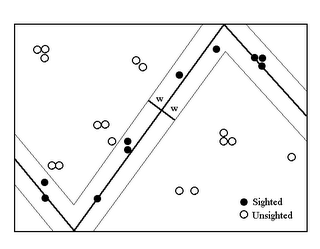 For those readers without much background reading, essentially with sightings surveys in large wide spaces, you can't feasibly count the number of animals located in the research region at one time - the North West Pacific is just too wide an expanse. What the scientists fall back to is determining paths through the research area along which they sail their ships, counting the number of whales they see, and then essentially extrapolate the sightings data to make an estimate of abundance within the entire research area [*].
For those readers without much background reading, essentially with sightings surveys in large wide spaces, you can't feasibly count the number of animals located in the research region at one time - the North West Pacific is just too wide an expanse. What the scientists fall back to is determining paths through the research area along which they sail their ships, counting the number of whales they see, and then essentially extrapolate the sightings data to make an estimate of abundance within the entire research area [*].In short, on these sightings surveys only a very small fraction of the whale populations have a probability of being sighted to begin with. This is especially easy to see when one considers that the IWC Scientific Committee estimates there to be 25,000 minke whales in the North West Pacific. JARPN II takes only 100 minke whales each year - just 0.4% of the estimated abundance. This is why people believe that JARPN II will not "damage the recovery of these populations", as EIA alluded to.
Of course, well done to EIA for twisting a sample size estimated to be between 0.20% and 0.78% of the estimated abundance into a "slaughter" of "up to 75% of the whales sighted", and going even further for the big media headline with their "almost every whale in sight" soundbite. Great stuff!
(EIA gets my nomination for "Deception of the year" award.)
“The fact that Japan is killing almost every whale they see is simply unacceptable and clearly unsustainable’ said Claire Bass, EIA Campaigner and member of the Scientific Committee to the International Whaling Commission (IWC).On the contrary, it's clearly not unsustainable, and it's a shame that Claire Bass would spoil the good name of the IWC Scientific Committee by making such statements under the title.
The situation for sei whales is also of grave concern. One hundred of the 336 sei whales observed during the latest three month cruise were killed. The population abundance of north Pacific sei whales is not known, but they are listed as endangered by the IUCN (the World Conservation Union).The Sei whale is indeed the most frequently sighted type of whale in the JARPN II programme, with almost 3 times as many sighted as minke whales (they are easier to spot than minkes due to their larger size). EIA have tried hard here to make a crisis out of the situation, but what the IUCN actually says is this:
The species' classification by IUCN as Endangered in the mid-1990s (under the 1996 categories and criteria) was based on an estimated decline of around 50% in worldwide total abundance over the last three generations. This assumes a generation time of roughly 20-25 years. Most of this decline would have occurred in the Southern Hemisphere, which had a much larger original population than the North Atlantic or North Pacific. While a change in classification to Vulnerable may be appropriate, there is a distinct lack of reliable survey data that could serve as the basis for reassessment.What Japan is actually doing (unlike the EIA) is conduct surveys to obtain reliable data that could serve as such a basis, amongst various other research objectives. Interesting that EIA would rather be upset than happy at news of the reconfirmation of high levels of Sei whale abundance - yet another positive whale conservation story.
Just to finish up with EIA, taking a look at the figures we can also see that they have followed the standard anti-sustainable use group methodology of highlighting the "worst" case scenario (which I have just debunked above, anyway):
Minke sightings: 135
Minke samples: 100 == 74%
Sei sightings: 336
Sei samples: 100 == 30%
Bryde's sightings: 173
Bryde's samples: 50 == 29%
Sperm whale sightings: 333
Sperm whale samples: 6 == 2%
Blue sightings: 42
Blue samples: 0 == 0%
Fin sightings: 100
Fin samples: 0 == 0%
Humpback sightings: 78
Humpback samples: 0 == 0%
Right sightings: 14
Right samples: 0 == 0%
One last, final comment. How come when Greenpeace put out a press release, it is splashed all through-out the western media (especially Australia), yet when EIA put out a press release, only a single site other than their own homepage runs the story? Seriously, I'm probably the second source on the Internet to make a mention of it.
Although we find Greenpeace's propaganda campaigns extremely unethical and dangerous, we have to admire the massive media network they have developed.
[*] The ICR has a primer on line-transect based sightings surveys for whale abundance estimation in the Antarctic here. The same principles apply in the NW Pacific. The same techniques are used for estimating the abundance of a range of wildlife besides whales.
Labels: Claire Bass, EIA, Whaling
Summer Holiday 2006 - Day 2
Having arrived in Yakushima first thing on Sunday morning on the overnight ferry, our first concern was to get something to eat. We hadn't had time to get any dinner the night before, and there were only drink vending machines on the ship.
As we disembarked, we noticed an information centre at the ferry port, but it didn't open until 8:30am, so we decided to take stroll to another part of the beach front to take a look around, and found a small rest area where we are some Pringles that I had brought with me from Tokyo. Eventually a souvenir shop on the other side of the road opened up at around 8:00, and we got some bread for lunch there. Already it was blazingly hot, and we headed back to the information centre at the port. The dock of the "Toppy" ferry that we would head back to Kyushu mainland from was also right there in the same place.
We killed a few moments in the information centre building before a lady came along to open it up at 8:30.
One of the "must do" activities at Yakushima is a 22 km hike (a day trip) through the middle of the island, eventually taking the fit and healthy to the foot of a massive Cedar tree reputed to be more than 7000 years old (known as "Jomon Sugi"), judging by it's size although scientific techniques have dated it at more than 2000 years - a good age nonetheless.
I had already booked lodgings on the south side of the island in Onoaida (the port was Miyanoura on the north of the island), so we decided to get ourselves to the other side of the island today (Sunday), do the Jomon Cedar tree hike all day on Monday, and then come back to the north side of the island and do something else on Tuesday before our ferry ride. The island is actually small enough that you can get to the entrance of the Jomon Sugi hike from pretty much anywhere - we were actually a little out of the way on the South side.
The lady who opened up the info centre was pretty helpful as we considered our options for the 3 days (2 nights) we would be there. Our main problem was not what to do, but how to get ourselves around the place. The lodge that I booked has a homepage which suggests that a car is a must have for transport, since there are few buses and taxis are expensive.
The info lady made the point that it might be pretty tough to take a car to the Jomon Sugi hike, because the car park at the entrance is quite small and can be crowded, meaning you may have to park another 1km away (on top of the 11km hike), not to mention being completely knackered after the walk.
Ultimately we concurred, thinking it'd be a waste of money to hire the car and then hardly use it that day, so we decided to take the (also more environmentally friendly) option of the bus from the lodge to the hike.
(As it turned out, we didn't save much money if any by this, more on that tomorrow.)
So, we decided that we'd look to take a rent-a-car to our lodge today, use the bus to get between the lodger and the hike entrance on Monday, and come back to Miyanoura port on Tuesday via bus as well.
The information centre lady called in a rent-a-car man, who signed us up for 12 hours in a small light vehicle. This was only about 4,500 yen or so - much cheaper than rent-a-cars in Tokyo. We discussed how we should return the car, since we really wanted to use it to get ourselves to the other side of the island, he said that he'd come and pick it up that night. In that case, I thought, can he bring a rent-a-car back to the lodge on Tuesday morning so that we can get back to Miyanoura? This is where we got lucky - the rent-a-car man said why don't we just take the car to the lodge today (Sunday), leave it at our lodge on Monday, and then use it again on Tuesday - he'd only charge for 2 days instead of 3.
SWEET!
So that's what we did. Our rent-a-car cost us about 8,200 yen for the trip, plus the 150kms or so we did until Tuesday afternoon cost us about 1,500 yen in petrol.
All set with our wheels and tourist information, we scootered off clockwise towards the east of the island. Eventually we found a supermarket, and so picked up some essentials - champagne, snack biscuits and sandwiches or something for lunch, if I remember correctly.
We soon found a nice spot to park on the side of the road and head down to the ocean.

[will write the rest of this later, the rugby starts soon]
(Not a bad game of Rugby by the way - 34-27 to the All Blacks)
So, as you can see from the picture above, we found a spot where we could get down to the beautiful North Pacific ocean and lots of rocks to go with it, and had our lunch (an early one) there, as I recall.
Hitting the road again, our next stop was one of Yakushima's famous waterfalls, Senpiro-no-taki (Google images). Besides the 60 metre waterfall, the massive rock face beside it is something in itself - quite a work of nature. Some other kind tourist took a photo of us.
 As you can probably ascertain from the photo, it had clouded over and just started to rain a little as we made our way up the hill to the waterfall, but it was just a small shower. There was also a viewing platform near the car park looking out to sea:
As you can probably ascertain from the photo, it had clouded over and just started to rain a little as we made our way up the hill to the waterfall, but it was just a small shower. There was also a viewing platform near the car park looking out to sea: As we came back down from the viewing platform towards the car park, a butterfly came to say hello:
As we came back down from the viewing platform towards the car park, a butterfly came to say hello:
 Back at the information centre the helpful lady had told us about a nice cafe type place not far from the waterfall, and we quickly found it as we drove back through the forest down towards the coast. There we went for some "tankan" (citrus type fruit) juice. Very good it was indeed.
Back at the information centre the helpful lady had told us about a nice cafe type place not far from the waterfall, and we quickly found it as we drove back through the forest down towards the coast. There we went for some "tankan" (citrus type fruit) juice. Very good it was indeed. The cafe building itself was the real attraction, containing a whole heap of cedar tree based craft work - no photos of that to show though. Outside there was a garden beside the tiny car park with some hibiscus flowers in full bloom. There are heaps of hibiscus around the southern region, including Okinawa, apparently.
The cafe building itself was the real attraction, containing a whole heap of cedar tree based craft work - no photos of that to show though. Outside there was a garden beside the tiny car park with some hibiscus flowers in full bloom. There are heaps of hibiscus around the southern region, including Okinawa, apparently.Hitting the road again, we went in search of more ocean and beach. The main road around the island was slightly inland on this south eastern part of the island, but there were lots of little narrow roads cutting off through farmland towards the ocean. We randomly selected one but after some minutes we decided that it didn't seem like it would to lead us to the water so we took in the mountain view instead, and a promotional camera shoot with the rent-a-car as well.
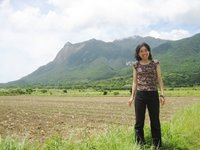
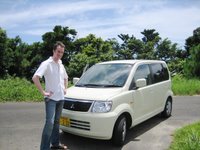 Another waterfall, Torooki-no-taki (Google images), was apparently not far from our lodge, so we put that next on our list, but had a struggle to find it. Apparently it is but one of two waterfalls in Japan that fall directly into the sea, so we were looking out for some kind of entrance on the left side of the road. Eventually we found that the way to get to it is by parking in a big souvenir shop on the right side of the road.
Another waterfall, Torooki-no-taki (Google images), was apparently not far from our lodge, so we put that next on our list, but had a struggle to find it. Apparently it is but one of two waterfalls in Japan that fall directly into the sea, so we were looking out for some kind of entrance on the left side of the road. Eventually we found that the way to get to it is by parking in a big souvenir shop on the right side of the road.Really beautiful it was too. The Senpiro-no-taki is just a big ugly waterfall really, with a bit of a "wow" factor to it, but the Torooki-no-taki was much more scenic. The clock had rolled past 13:00 by the time we took the snap below:
 Back to the souvenir shop we went, and had some more food. They were selling hot-dog style bread rolls dirt cheap, and I seem to remember downing some more tankan juice as well.
Back to the souvenir shop we went, and had some more food. They were selling hot-dog style bread rolls dirt cheap, and I seem to remember downing some more tankan juice as well.Next we stopped off at our lodge and said hello to the staff (a really nice guy, originally from Chiba). We had hoped to take a shower, having not had the chance on the overnight ferry, but we arrived before check-in so that was a no go. But he gave us some more tips on other nice stuff to see for the rest of the afternoon - specifically another waterfall, Ooko-no-taki (even more Google images). Apparently here there was also a nice not so visited beach as well, so off we set again.
 It wasn't long before the blue ocean distracted us again though, and we found ourselves driving off down another road on the off chance that it might lead us to the ocean. Again, it didn't, but we found some nice views of the ocean near a dairy farm. We found a proper tourist viewpoint not too much further along the main road, past this little side street, which had pretty much the same view.
It wasn't long before the blue ocean distracted us again though, and we found ourselves driving off down another road on the off chance that it might lead us to the ocean. Again, it didn't, but we found some nice views of the ocean near a dairy farm. We found a proper tourist viewpoint not too much further along the main road, past this little side street, which had pretty much the same view. Next it was a short 5 minute or so stroll down to the beach, where one of us had a bit of a play about, skimming stones etc. There was lots of hot sand here this time, unlike the previous place, but there were still lots of little stones to bash your feet as the waves broke on the shoreline.
Next it was a short 5 minute or so stroll down to the beach, where one of us had a bit of a play about, skimming stones etc. There was lots of hot sand here this time, unlike the previous place, but there were still lots of little stones to bash your feet as the waves broke on the shoreline.Anyway, we sure had gotten about the place on this, our second day of summer vacation, and so headed on back to the lodge for that long awaited shower and some dinner.
The lodge here on Yakushima was probably the best dinner setting of the whole trip. Our room was in a detached building of three rooms, and the people who run the lodge have a dinner area in their main building, where the guests have their feed (this was a "minshuku", which is a kind of private home that provides rooms and food, as opposed to a stiff hotel). However they have a nice big veranda outside as well, so we opted to have dinner outside. All sorts of tasties on the menu, including some of that flying fish that we had seen on the ferry before arriving in the morning.


Labels: Kana and I, Summer Holiday 2006
8/13/2006
Summer Holiday 2006 - Day 1
So on the 5th of August I left home for Tokyo's Haneda Airport for my long awaited summer holiday in southern Japan with Kana. Our plan was to take in sights in Kyushu (Yakushima, Ibusuki, Kagoshima, Beppu), Hiroshima, and finally Matsuyama in Shikoku, Kana's home town.
This was actually my first domestic flight but shortly after 1pm I arrived at Kagoshima airport and met up there with Kana who had arrived on a flight from Matsuyama about half an hour earlier. We had no set plans for the day other than to basically meet up and then get ourselves on our way down to Yakushima to really start our trip the next day, but the first day was actually quite good in itself.
First we rode a bus from the airport down south into Kagoshima city (about 50 minutes), and then took a walk around the town. Apparently Kagoshima is famous for Chinese noodles ("ramen"), so we had some for lunch. Something else Kana spotted was "shirokuma" (so called "polar bears") which is actually just a dessert type of thing which apparently originates out of Kagoshima. We were really looking for Kagoshima ramen at the time though, and skipped it, but had some a few days later when we made our way back from Yakushima (more on that at a later date).

Having taken a quick look around the Kagoshima city centre we found our way to another bus terminal which took us to the Haibiskasu ferry, which was an over night ride down to Yakushima. We underestimated the distance to the port so ended up arriving just a few minutes before the boat was scheduled to depart. This is not your normal ferry by the way, it's more of a freight ship that seems to carry supplies down to Yakushima and the other big island nearby (see the map!). They have a few passenger cabins on board to take people as well, but there are no bunks or anything - just big communal rooms with carpet to sit on - so we sat ourselves down in one of those. Why this boat? Well because it was cheap - 2,700 yen - and would get us to Yakushima by 7am the next morning. The alternative was to pay for both faster transport and lodging which would work out at easily more than 10,000 yen, depending on just how extravagent we wanted to get.
Anyway, when the ship left port, we went out on deck and enjoyed the ride. The sea was pretty smooth. Kagoshima is also close to what is apparently still an active volcano in Sakurajima, and there was some kind of cloud hanging around the summit when we left.

We hung around out on the deck as the ship made it's way out of the large natural bay where Kagoshima is located, down south towards the first stop of Nishinoomote on Tanegashima. We got a pretty nice sunset to enjoy, and if my memory serves me right there was a nice moon lit sky as well.
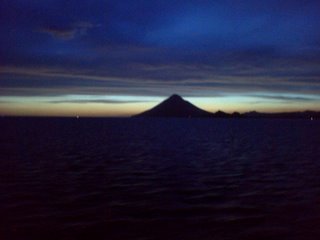
We eventually hit the carpet cabin floor at around 20:30 or so, and a short while later the boat arrived at Nishinoomote, where it stopped over night.
I was pretty tired that night (with the start of a cold) and actually got a good night's sleep. The ship departed port again at around 5a.m. the next morning, at which point we woke up, and again went out on deck and took in the sunrise this time - really nice it was too.

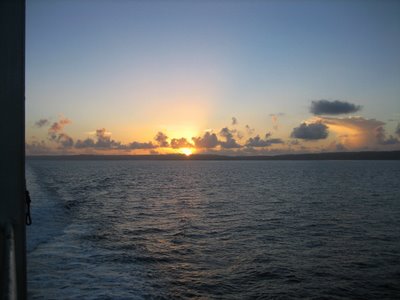
Standing towards the bow of the ship, we started to spot the odd flying fish as we headed southwest towards Yakushima, and as we got closer and closer, rather than spotting them in ones and twos we started to see larger schools of several dozen fish suddenly fly out of the water to avoid the wake of the ship, sometimes flying at what seemed to be as much as 30 or 40 metres. By 7a.m. we had arrived at Yakushima to a beautiful sunny day.

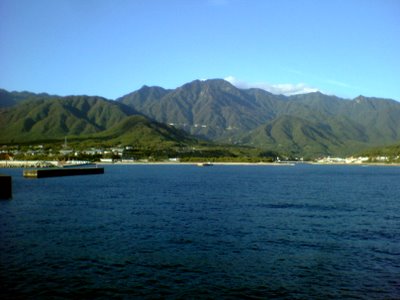
Day 2 will start here tomorrow - lots of waterfalls, beautiful blue sea, green mountains and so on to come.
Labels: Kana and I, Summer Holiday 2006
Summer Holiday 2006 - Part 0
Labels: Kana and I, Summer Holiday 2006
8/05/2006
Whaling: Australia scientists still developing new ageing technique
As is always the way, they have re-released this information again this year, and still nothing has changed. The technique still hasn't been developed, and the fact they are trying to develop such a technique at all is a concession that lethal research is the only way to obtain age information about whales.
Some thoughts:
- Even if one day it works for one whale, how practical would it be to apply it to 850 randomly selected whales in the JARPA II survey area around Antarctica? Perhaps Greenpeace activists in inflatables could amuse themselves by trying to see how much whale skin they could gather, to help answer this question. Look for some more whale poo while they are at it.
- What is the point of this anyway? Whale age information is not being gathered just for the hell of it - those interested in it are interested in it because they want to use the information in population modelling to aid in the setting of safe commercial whaling catch limits. Whether whales are killed for science or directly for dinner, the whales do not care much, I believe. But, as Nick Gales notes at the end of the article, they see some political benefit in the development of such techniques, and so long as they don't regard this as a waste of time, good on them. Would be nice if they'd try to contribute to real conservation efforts though.
Labels: Nick Gales, non-lethal research, Whaling
Whaling: Moratorium gets undue credit again
There was a period during which whales were hunted to the point of extinction. But thankfully, largely due to the international whaling ban, their numbers are once again increasing.The moratorium has nothing to do with the increases in the humpback whales mentioned in this article, they were protected in 1963 as I noted in my piece "Reflection - the Moratorium and John Gulland".
Also of interest in the article:
No part of the whale went to waste.No mention of who it was that ate the whale meat.
Archives
June 2004 July 2004 August 2004 September 2004 October 2004 November 2004 December 2004 January 2005 March 2005 April 2005 May 2005 June 2005 July 2005 August 2005 September 2005 October 2005 November 2005 December 2005 January 2006 February 2006 March 2006 April 2006 May 2006 June 2006 July 2006 August 2006 September 2006 October 2006 November 2006 December 2006 January 2007 February 2007 March 2007 April 2007 May 2007 June 2007 July 2007 August 2007 September 2007 October 2007 November 2007 December 2007 January 2008 February 2008 April 2008 May 2008 June 2008 July 2008 August 2008 September 2008 October 2008 November 2008 December 2008 January 2009 February 2009 March 2009 April 2009 May 2009 June 2009 July 2009 August 2009 September 2009 October 2009 November 2009 January 2010 February 2010 April 2010 May 2010 June 2010 July 2010 August 2010 September 2010 February 2011 March 2011 May 2013 June 2013

